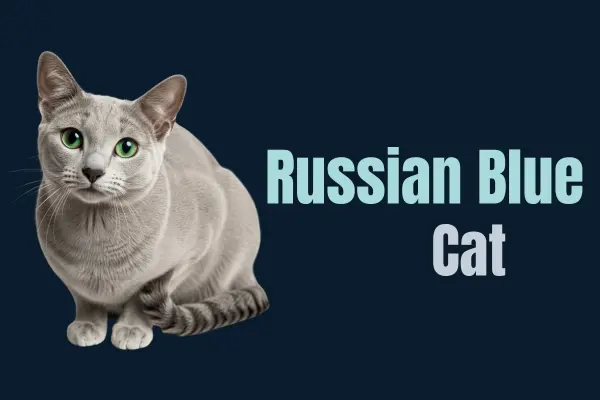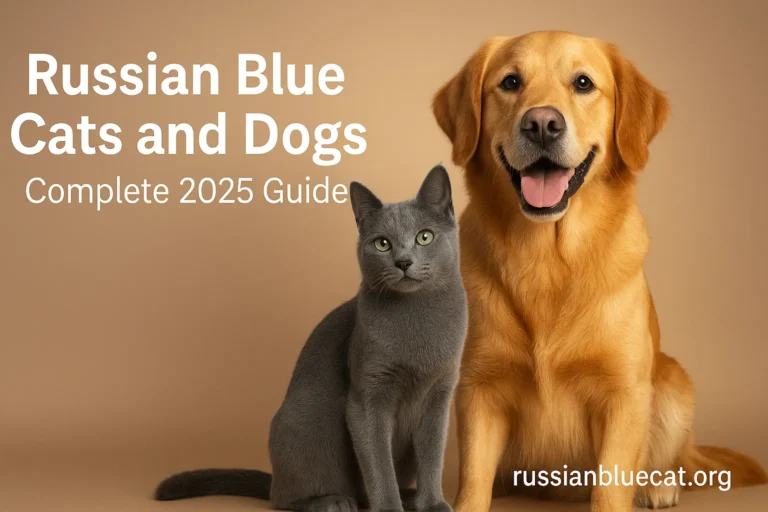Russian Blue Cat Diet: The Complete 2025 Owner’s Guide
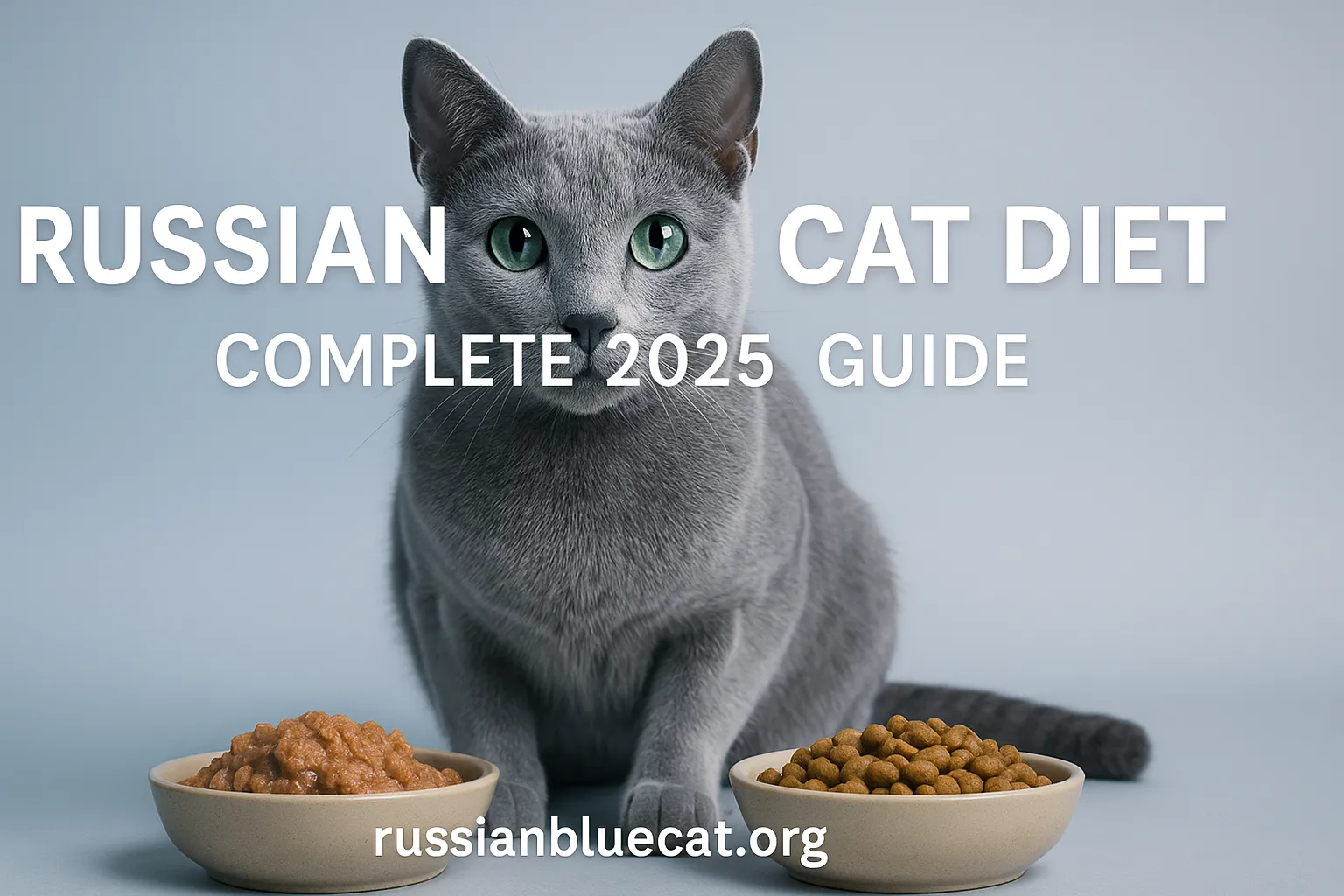
Introduction
Russian Blue Cat Diet is one of the most crucial factors in bringing up this beautiful and enigmatic breed. Famous for their silvery-blue double coats and arresting emerald green eyes, Russian Blues tend to mesmerize with their beauty. But behind that beauty is a cat with very particular dietary requirements. Unlike some cats who can dine on whatever variety of foods with little ill effect, Russian Blues tend to gain weight if their eating is not tightly controlled.
Nutrition for your Russian Blue is more than spilling kibble into a bowl it is about knowing the special biology and lifestyle of this cat. Their peaceful nature, muscular physique, and stealthy habits need fuel that promotes health without causing obesity. A balanced Russian Blue Cat Diet will make your cat lean, vibrant, and content for years to come.
Knowing the Russian Blue Before Creating a Diet
The Natural Physique
Russian Blues can look more substantial than they are because of their thick coat, but beneath the surface is a strong and lean body. They developed in the harsh Northern Russian climate, namely the port city of Arkhangelsk. There, they needed to be able to get by on fewer calories in order to survive, and have powerful muscles to hunt with. Consequently, their metabolism is geared to save energy, which translates to modern Russian Blues Cat gaining weight very easily if overfed.
Activity Level and Personality
Russian Blues are not hyperactive breeds like Abyssinians or Bengals. Russian Blues are routine-oriented, intelligent, and quiet cats. They like regular routines and peaceful homes. They do enjoy play bursts, but they are not hyperactive. This lower energy level in relation to some breeds makes portion control within the Russian Blue Cat Diet particularly important.
Nutritional Foundations of a Healthy Russian Blue Cat Diet
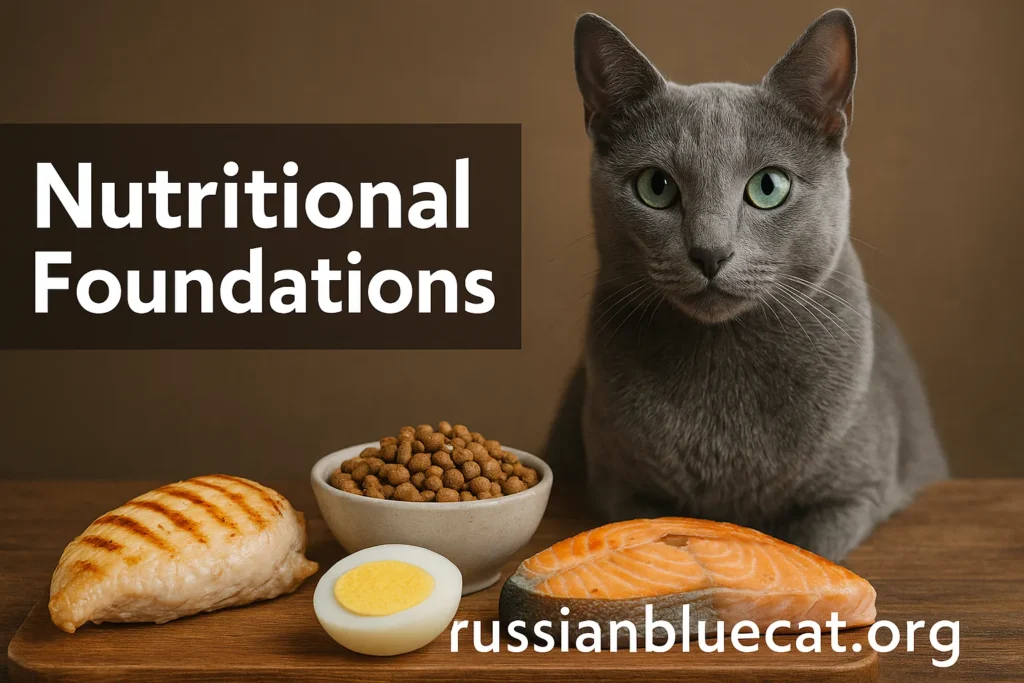
Protein: The Cornerstone of Every Meal
Protein is the centerpiece of a healthy Russian Blue Cat Diet. Being obligate carnivores, Russian Blues feed optimally on meat-based protein that maintains muscle, energy levels, and organ health. If there’s not enough protein, a Russian Blue will lose muscle tone, have a dull coat, or even exhibit lowered immunity.
Optimal Protein Sources for Russian Blues:
- Chicken and turkey (lean, easily digestible)
- Fish such as salmon or tuna (abundant in Omega-3s)
- Rabbit or duck (new protein sources for finicky cats)
When scanning cat food labels, protein must always be the leading ingredient. Steer clear of foods in which grains or fillers lead the list.
Fats: Necessary for Energy and Coat Health
Fats are also vital in the Russian Blue Cat Diet. Healthy fats are a rich source of energy and are also the cause of the breed’s luscious coat shine. Omega-3 and Omega-6 fatty acids, present in fish oil or flaxseed oil, make their skin soft and prevent over-shedding.
However, balance is key. Too much fat can quickly increase calories, contributing to weight gain. Look for foods that balance protein and fat without adding unnecessary carbohydrates.
Carbohydrates: Keep Them Minimal
Cats do not need much or any carbohydrates, and the Russian Blue is no different. Their gut is not geared for processing high amounts of grains. Eating high-carb foods will cause them gastrointestinal issues and unwanted weight gain. Optimally, the carbohydrate content in their diet should be from small quantities of vegetables or fiber, not wheat, soy, or corn.
Wet Food vs. Dry Food: Choosing the Right Mix
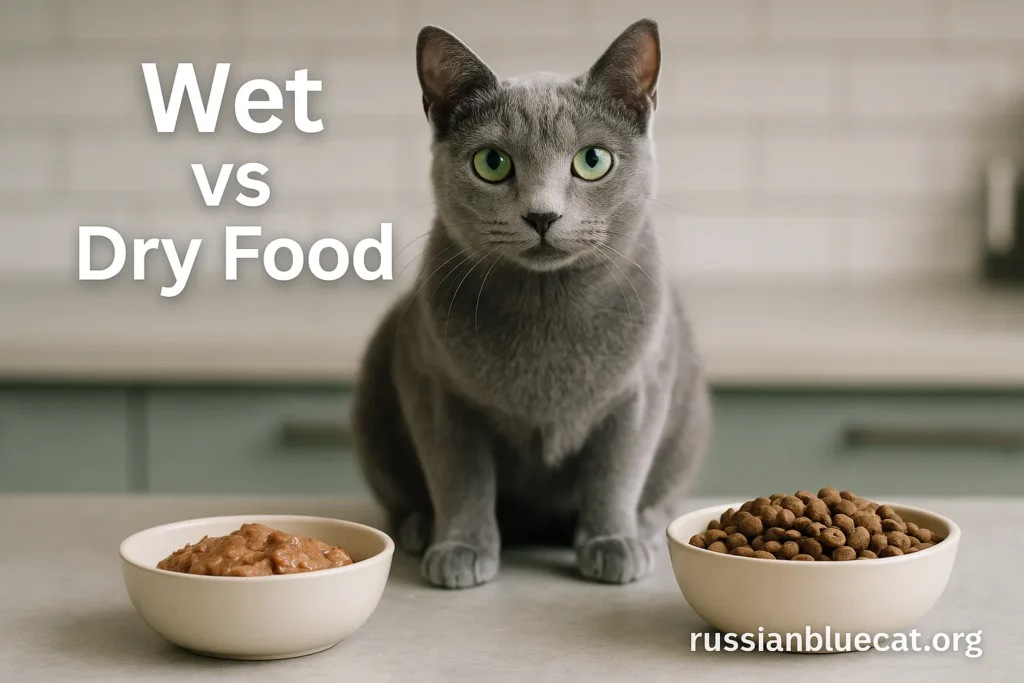
The Advantages of Wet Food
Russian Blues are greatly advised to be fed with wet food since it has approximately 70–80% water content. This prevents cats from developing urinary tract infections and kidney disease, which they are mostly susceptible to. It also offers a more natural diet from prey, with high protein in a moist state.
The Advantages of Dry Food
Dry food has its place in the Russian Blue Cat Diet, mainly for convenience. It is easy to store, measure, and feed. The crunch of kibble can also support dental health, though it should not replace regular tooth brushing.
The Best Approach
Most vets suggest a mix of wet and dry food. Wet food provides hydration and digestibility, while dry food provides variety and convenience. The importance is to portion carefully and not leave free-feeding dry kibble out, as Russian Blues have a tendency to overeat.
Feeding Schedule and Portion Control in the Russian Blue Cat Diet
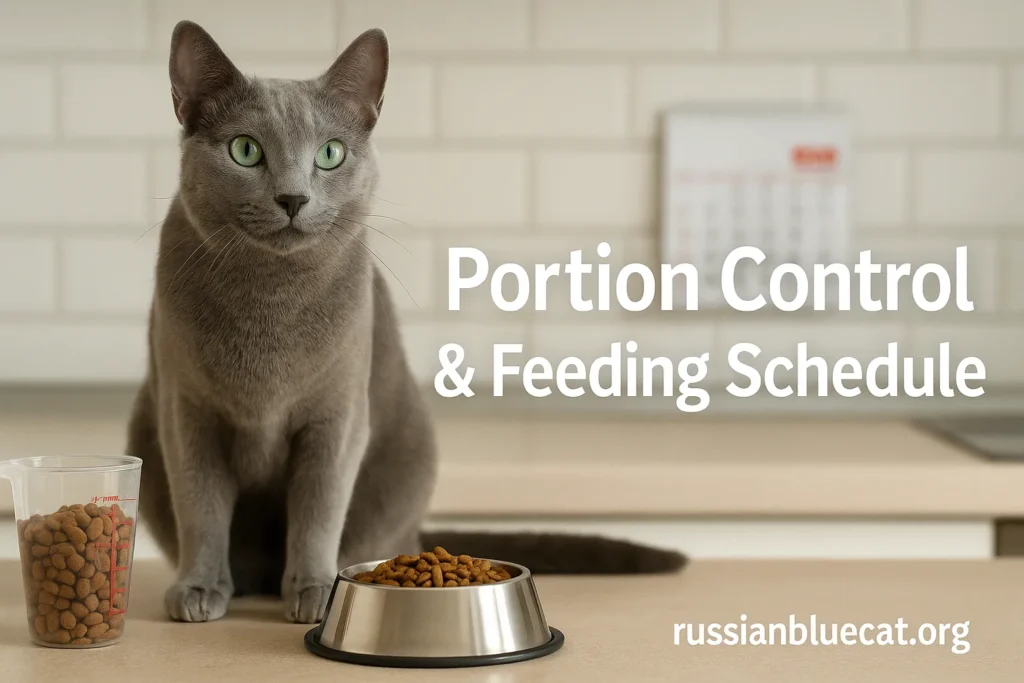
Daily Caloric Needs
A typical adult Russian Blue needs 180–230 calories daily. This might appear minimal, but bear in mind their metabolism is highly efficient. Overfeeding them outside these limits on a day-to-day basis will result in slow and persistent weight gain masked beneath their dense coats.
Kittens, due to their fast growth rate, require much more calories and more frequent meals. Seniors need fewer calories but could make use of supplements for kidney and joint wellness.
Regular Meal Times
Cats are comforted by routine, and Russian Blues particularly. Having them eat at regular times (more than likely morning and evening) not only provides a sense of security but also allows you to portion accurately and prevent overeating.
- Kittens: 3–4 small meals per day
- Adults: 2 measured meals per day
- Seniors: 2 small meals with adjusted calories
Avoid the temptation to leave a full bowl of kibble out for free feeding—Russian Blues are clever enough to take advantage of it, and this habit almost always leads to obesity.
Monitoring for Overfeeding
Because their dense fur hides body changes, owners must use the “rib test.” Place your hands over the cat’s midsection if you can’t feel the ribs or a distinct waistline, portion sizes need to be changed. Daily weighing every few months also catches small changes before they become an issue.
Best Foods for Russian Blue Cats
High-Quality Commercial Foods
When choosing commercial cat food, pick brands with real meat as the leading ingredient. Low-grain or grain-free foods are ideal for upholding muscle and reducing obesity.
Ideal Russian Blue Cat Diet Options:
- Royal Canin Feline Health Nutrition – tailor-made for indoor cats.
- Hill’s Science Diet Indoor Adult – maintains lean muscle and digestive function.
- Orijen Cat & Kitten – high-protein, biologically fit diet.
- Purina Pro Plan Focus – well-balanced diets for sensitive digestion.
Not only are these foods balanced but also accredited under strict standards such as those of the AAFCO, which makes them safe and dependable options.
Homemade Diet Options
Others like to feed home-cooked foods, particularly for cats with allergies or digestive issues. Cooked chicken, turkey, or salmon can be on the Russian Blue Cat Diet, accompanied by a small amount of pumpkin or green beans to provide fiber.
But homemade diets must be managed carefully. Taurine (vital for heart and eye function) can’t be omitted. Always get professional advice from a vet or pet nutritionist when creating a home-cooked meal plan.
Foods to Avoid
Some foods for humans are poisonous to cats and must never be part of the Russian Blue Cat Diet:
- Onions, garlic, and chives (harm red blood cells)
- Chocolate and caffeine (poisonous to the nervous system)
- Grapes and raisins (can lead to kidney failure)
- Alcohol and raw dough (extremely toxic)
Safe foods must still be given in moderation and only occasionally.
Hydration in the Russian Blue Cat Diet
Why Water Matters
Hydration is essential for Russian Blues since they can develop urinary tract problems if they are not properly hydrated. An over-reliance on dry kibble without added hydration can put stress on their kidneys.
Spurring Hydration
Russian Blues, and many cats may not tend to drink much water without prompting. Owners can motivate them with:
- Creating a cat water fountain (running water is very enticing to them).
- Adding water or broth to food.
- Upgrading wet food in the diet.
- Providing unsalted bone broth every now and then as a treat.
Signs of Dehydration
Be on the lookout for signs of lethargy, dry gums, or skin that fails to snap back when pinched gently. These are warning signs that your cat is not drinking adequately.
Weight Management and Obesity Risks
Why Russian Blues Are Prone to Weight Gain
The mild demeanor of Russian Blues, with the added fact that they like to beg using their expressive eyes, places them in particular danger of overeating. Owners yield, believing a little more won’t hurt but eventually, this behavior contributes to obesity.
Health Risks of Obesity
Overweight in Russian Blues can lead to:
- Diabetes
- Joint issues such as arthritis
- Shortened lifespan
- Grooming problems due to limited mobility
Preventing Obesity
- Measure portions exactly don’t estimate.
- Playtime with toys to stimulate activity.
- Slow feeder puzzle toys to slow eating and challenge the brain.
- Veterinary check-ups regularly to monitor weight and body condition.
Special Dietary Needs at Different Life Stages
Kittens
Russian Blue kittens are a bundle of energy, and their growth rate is rapid in the first year. They should be fed a diet of higher protein and fat to nurture muscle, bone, and brain development. Kittens require three or four small meals every day that are packed with nutrient-rich food.
Foods specifically formulated for kittens such as Hill’s Kitten Healthy Development or Royal Canin Kitten contain the added calories, taurine, and vitamins required. Do not use adult foods in kittens because they will not support growth.
Adults
Adult Russian Blues require a balanced mix of protein, fat, and limited carbohydrates. Being less active, portion control is essential. Adult foods should emphasize lean proteins (chicken, turkey, fish) and portion control to avoid obesity.
Seniors
Senior Russian Blues (10 years and above) usually need lower-calorie diets, but with high digestibility. Supplements such as glucosamine, or renal-support formulas, would be needed. Soft or wet foods are particularly helpful because they aid in hydration and are gentle on aging teeth.
Supplements in a Russian Blue Cat Diet
Fish Oil
Fish oil is a great supplement for Russian Blues. It increases coat luster, lessens inflammation, and boosts brain function.
Probiotics
Probiotics improve digestion and support immune health. For a breed with sensitive stomachs, they can reduce gastrointestinal issues.
Glucosamine & Chondroitin
These are especially useful for senior Russian Blues, as they reduce joint stiffness and support mobility.
Multivitamins
Generally, a balanced Russian Blue Cat Diet doesn’t require multivitamins if you’re feeding high-quality food. However, under vet guidance, they can be added for picky eaters or cats with medical conditions.
Safe and Toxic Human Foods
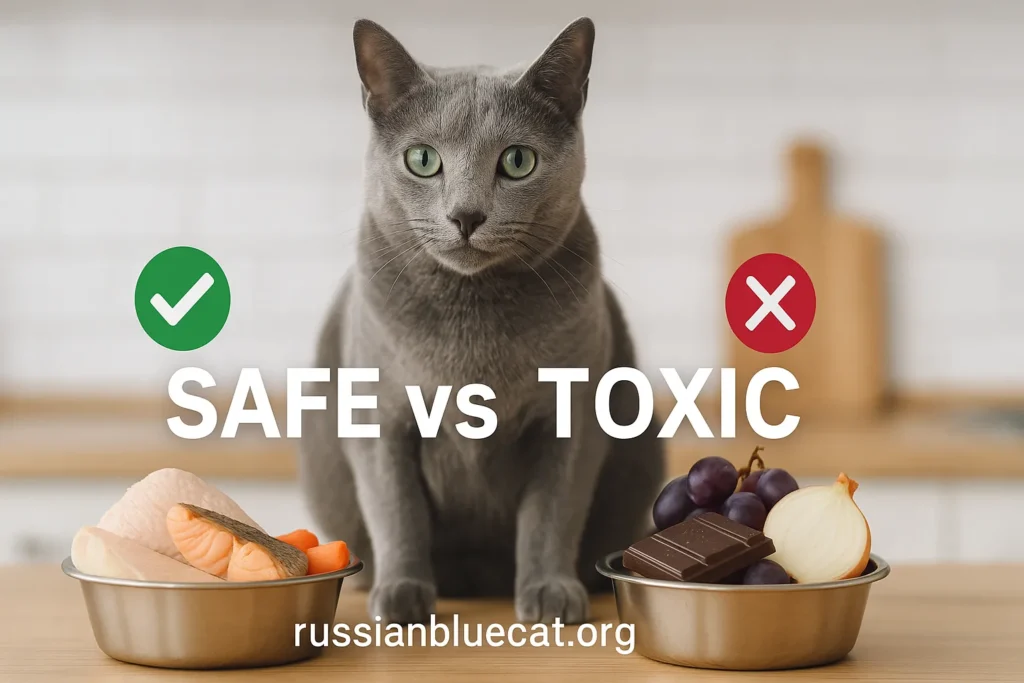
Safe Choices (Infrequent Delights)
- Grilled chicken or turkey – lean protein supplement
- Baked salmon – contributes Omega-3
- Scrambled egg (plain) – healthy protein source
- Pumpkin puree – helps digestion
- Plain yogurt (small quantity) – probiotic benefits
Hazardous & Toxic Foods
- Onions, garlic, chives – red blood cell destroyer
- Chocolate, coffee, tea – nerve system toxins
- Grapes & raisins – associated with kidney failure
- Alcohol & raw dough – life-threatening toxins
- Fat trimmings or bones – choking hazard & digestive damage
In doubt, stay with specifically developed cat foods and keep human food treats to a minimum.
Grooming and Diet Connection
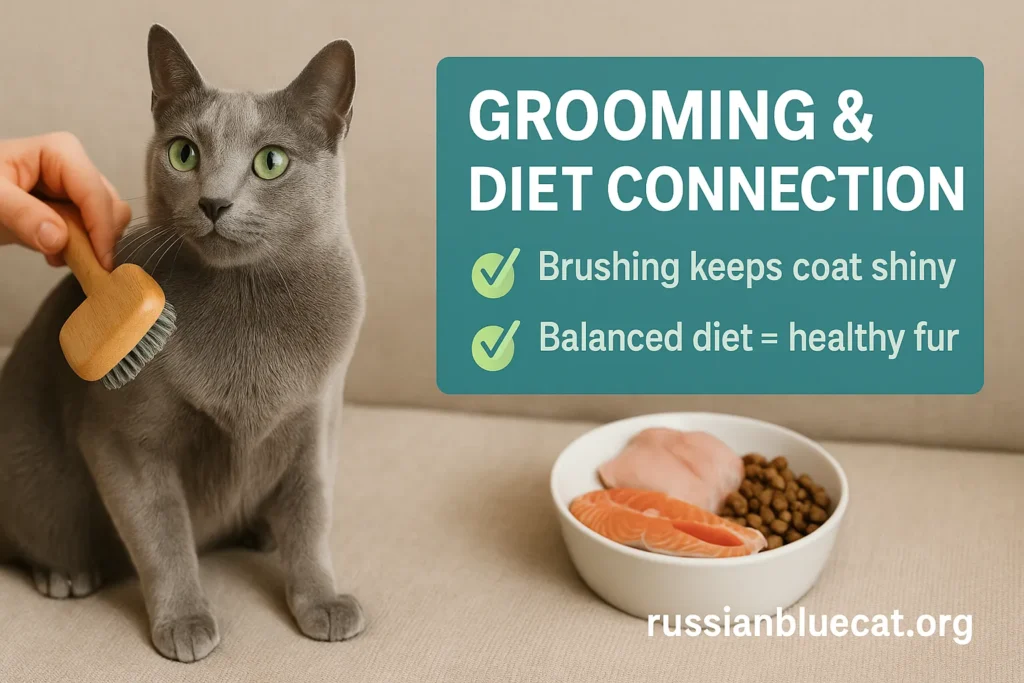
One of the most obvious indicators of a good diet is a healthy coat. A Russian Blue’s luxurious double coat dulls, thins, or excessively sheds when their nutrition is lacking.
A thoughtfully designed Russian Blue Cat Diet with plenty of protein and fatty acids leads to:
- Sparkling, smooth coat
- Less shedding
- Healthy skin with less irritation
- Strong teeth and nails
In short, grooming is easier and more efficient when a proper diet is established.
Common Feeding Errors
- Free-feeding dry kibble – weight gain.
- Over-treating – those little snacks pile up in a hurry.
- Ignoring portion control – estimating portions always means overfeeding.
- Skipping water – cats usually don’t hydrate on their own.
- Feeding only one food – variety (wet + dry) for complete nutrition.
Repairing these errors can immediately enhance a Russian Blue’s health and avoid long-term issues.
FAQs On the Russian Blue Cat Diet
Conclusion
The Russian Blue Cat Diet is not just about feeding it’s about establishing a lifestyle that fosters longevity, beauty, and vitality. By emphasizing lean protein, healthy fats, low carbs, and control of portions, the owners can avoid obesity and medical conditions.
Hydration is just as important, so wet food and fountains of running water are best. Adding supplements such as fish oil or probiotics helps to give them an added boost, and steering clear of toxic foods keeps them safe.
With a strict, nutrient-dense diet, your Russian Blue will return the love with decades of companionship, silent devotion, and sheer beauty.
For reliable nutritional guidelines, you may go to the American Association of Feed Control Officials (AAFCO), which sets the benchmark for safe, balanced pet food.
